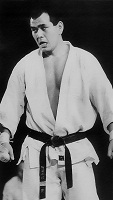The 1st World Kyokushinkai Championship 1975
Katsuaki Sato

|
The 1st World Kyokushinkai Championship 1975
Katsuaki Sato |
|
|
The First World Open Karate Tournament was held on the 1st and 2nd of November, 1975 in Tokyo under the auspices of the International Karate Organization, Kyokushinkaikan.
|
|
|
1.
Katsuaki Sato - JAPAN |
However, recognizing the need for a certain degree of protection for
tournament purposes, rules banning any hand contact to the face, contact
to the groin and grabbing were formulated. Further, exponents received
penalties for running out of the ring too many times, for bad attitude
and for being hesitant to engage in battle. |
|
Hatsuo Royama
|
Exponents won either by Ippon(one point), or Waza-ari (half a point),
judges |